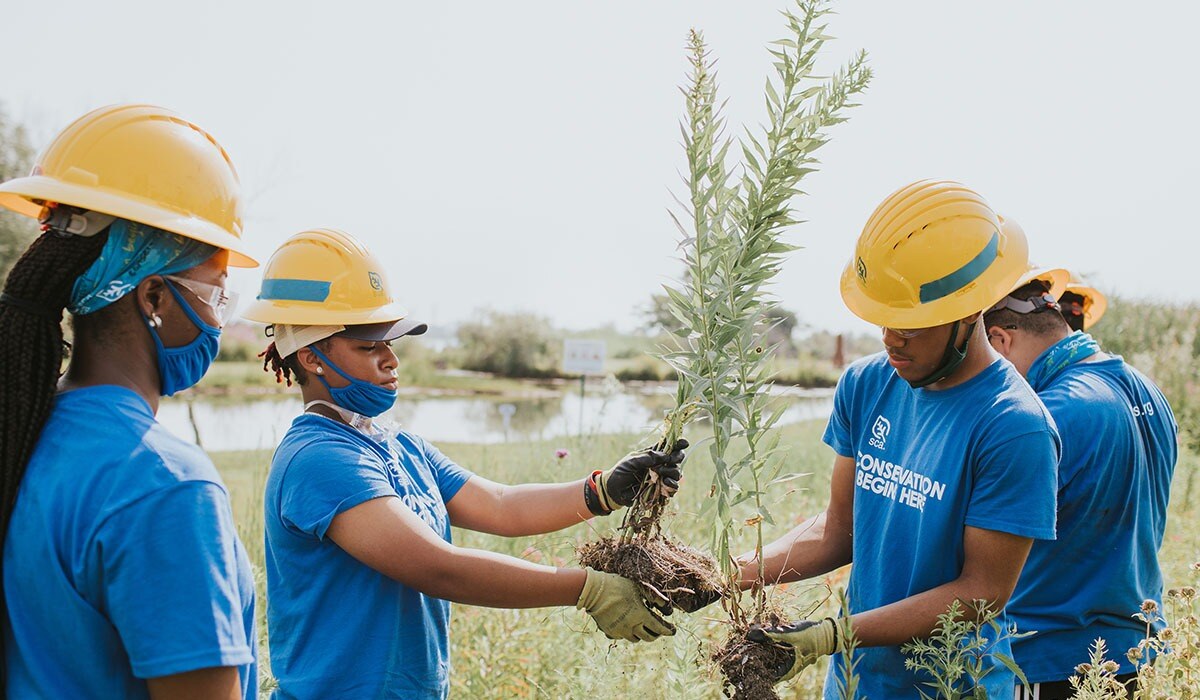Blog
Building Resilience with Conservation and Nature Programs
All young people deserve to have access to opportunities and programs that help them discover their sparks, build positive relationships with others, and develop a positive sense of their own identity.
Participation in conservation and nature programming is one youth development space where young people may experience the positive benefits of a high-quality youth program. For example, youth in conservation and nature programs have opportunities to use their entire bodies to work toward shared goals, to be vulnerable and stretch beyond their comfort zones, and serve a larger purpose.
- What are the benefits of conservation and nature programs for positive youth development?
- And what are the characteristics of high-quality conservation and nature programs?
Benefits of Conservation and Nature Programs
Past research shows that working in nature as part of an exemplary conservation program can be enormously beneficial for young people.
When young people spend time in nature, they tend to experience improved physical, mental, and emotional health (Syvertsen et al., 2022). A study of how nature experiences promote positive development for adolescents in rural South Carolina found that adolescents who reported moderate to high levels of both connection to nature and time spent in nature also reported increased levels of confidence, competence, and connection (Bowers et al., 2021)
Conservation experiences can also help young people achieve intrapersonal and relational outcomes that might include asking for help when needed, communication, persistence, and collaboratively working with others. Moreover, adolescents who experience nature and conservation often feel increasingly connected to the greater good (Wray-Lake & Syvertsen, 2011; Wray-Lake et al., 2016) and are more apt to think of the environment and nature as a shared public space/resource as they get older (Flanagan et al., 2016).
This research demonstrates the power of hands-on conservation experiences for young people developing a sense of who they are, what they are capable of, and what they hope to do as part of a community and an active participant in an interconnected world (D’Amato & Krasny, 2011; Louv, 2012).
Learning from an Exemplar in the Field: Student Conservation Association
To better understand the ways in which nature conservation support the growth and development of young people, Search Institute took a closer look at an exemplary program known as the Student Conservation Association (SCA).
Over the past decade, we have collaborated with SCA on research and evaluation projects to deepen understanding of their program model and impact on youth participants. Through this work, we have engaged program leaders, staff, and young people in rich conversations about their experiences.
The SCA seeks to build the next generation of conservation leaders by engaging young people in hands-on service to the land through internships with stipends. SCA is a national leader in preparing high school-age youth and young adults for a lifetime of conservation service, with more than 100,000 alumni across the country. SCA members serve in either year-round programs or summer programs that last two weeks to two months. Youth work in parks, public lands, and urban green spaces to make improvements and learn conservation and sustainability practices. SCA teaches them how to plan, enact, and lead, all while making a tangible impact in conservation.
Findings from SCA showcase the unique characteristics of the program, the features it has for facilitating developmental relationships among participants, helping young people ignite their deep personal interests or sparks, empowering them and give them voice, contributing to social-emotional learning, and supporting their thriving through contribution to something greater than themselves.
Lessons for All Youth Programs
Grounded in previous research and real-world examples, our most recent report highlights five cross-cutting themes building on findings from SCA and two other exemplary programs in the performing arts and youth sports space. These themes illustrate how high-quality youth programming can support young people’s positive development, with developmental relationships as the necessary catalyst for delivering other key components of a high-quality positive youth development experience. Moreover, SCA and the other two programs have invested heavily in breaking down financial, cultural, and access barriers to ensure youth from some of the most under-resourced neighborhood and urban centers have access to these high-quality youth programs.
- They provide developmental relationships with adults that go beyond caring.
- They enable young people to pursue a common goal that fosters positive peer-to-peer connections and relationship-building skills.
- They provide voluntary, youth-initiated activities that foster autonomy, a greater sense of personal identity, and confidence.
- They expose young people to more authentic learning opportunities, resulting in greater motivation and purpose for learning important life skills.
- They provide opportunities for youth to identify their sparks, overcome challenges, and develop both performance and moral character.
By investing in high-quality programs that build on this knowledge, we can help the next generation to grow up connected to each other, to the adults in their lives, and to the Earth they inherit.
Syvertsen, A. K., Scales, P. C., Wu, C-Y., & Sullivan, T. K. (2022). Unpacking the grey box of youth development programs: Character development through youth conservation. Journal of Positive Psychology. Advance online publication.


